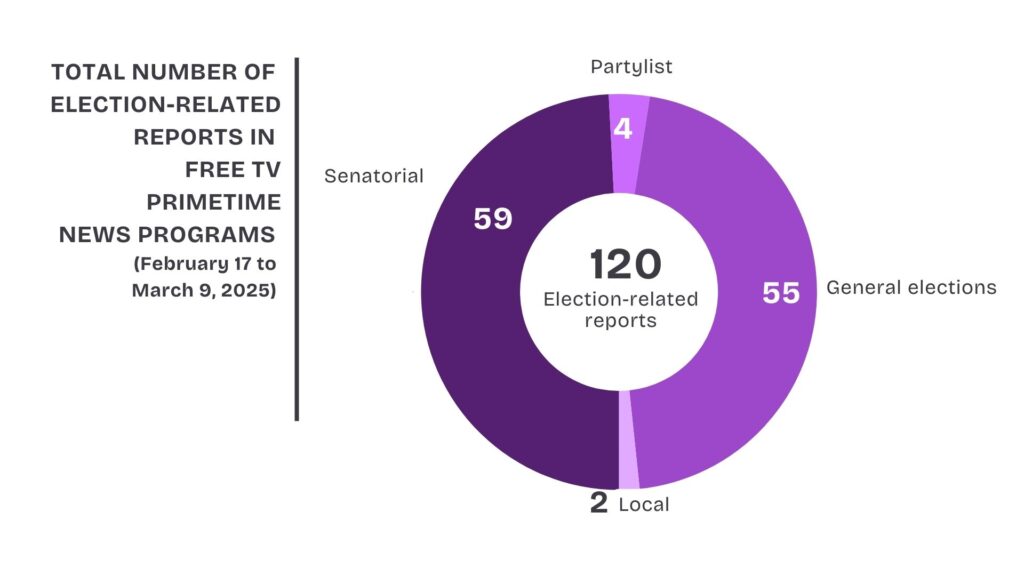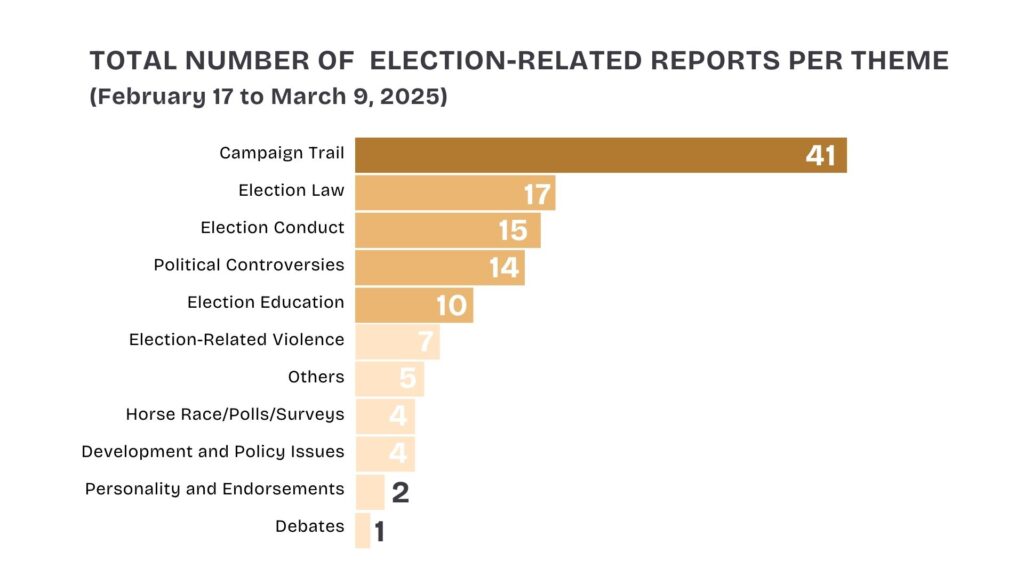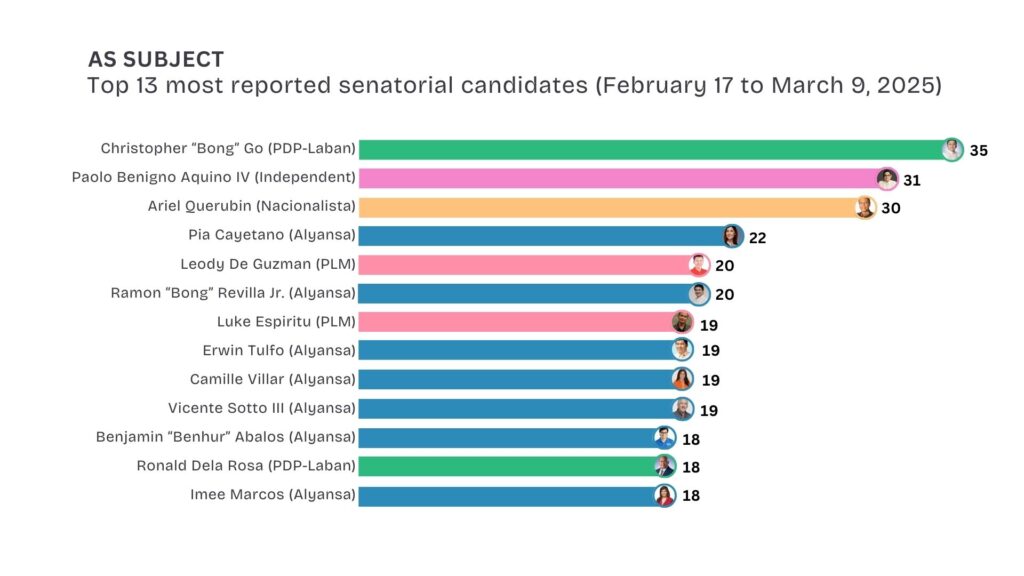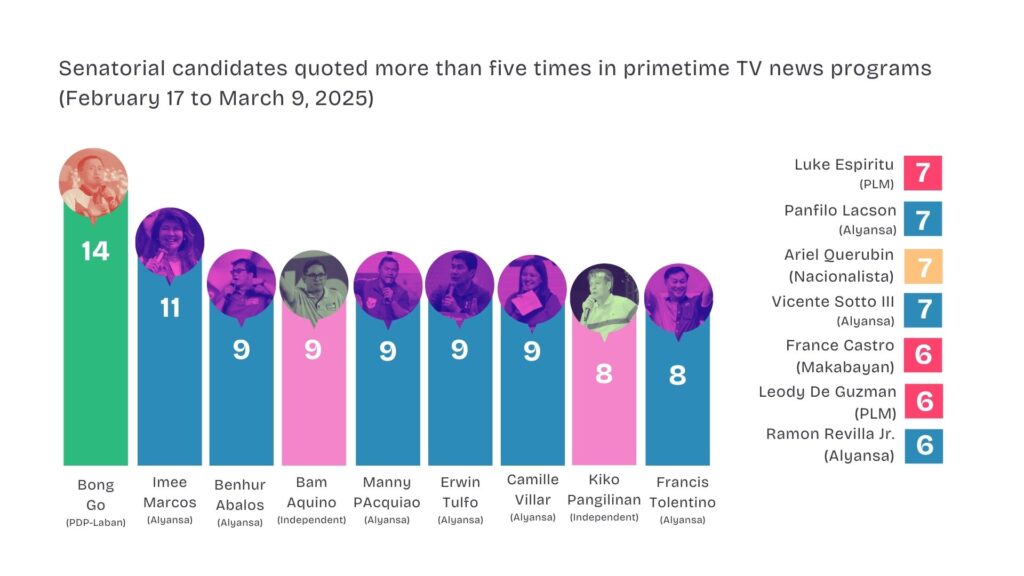Feb 17 to March 9, 2025: Airtime for election news dips

METHODOLOGY: CMFR reviewed and analyzed the primetime news programs of four broadcast stations: GMA-7’s 24 Oras and 24 Oras Weekend; ABS-CBN’s TV Patrol and TV Patrol Weekend; TV5’s Frontline Pilipinas and Frontline Pilipinas Weekend; and NewsWatch Plus’ News Watch Now (no weekend program) for three weeks, from February 17 to March 9, 2022.
ALSO SEE: “Kicking off the campaign period: Admin-backed senatorial candidates receive more TV news mileage“
ELECTION COVERAGE during the second, third, and fourth weeks of the campaign period consolidated news on campaign sorties and rallies of senatorial candidates into single reports. This collective reporting remained candidate-centric, with short annotations on what the candidates did or said during a campaign event, including their platforms or comments on certain issues. While this strategy ensured broad exposure for senatorial bets, it gave scant space for presenting their qualifications and track records, not to speak of analyzing the candidates’ platforms or discussing other issues involving the candidate.
Mid-term elections are never as engaging as presidential elections, and the coverage in 2025 reflects this difference. Newsrooms seem unable to present local campaigns through graphics perhaps; or to focus on interesting developments in different provinces or cities, creating a larger frame for local or regional news.
But the current dip is startling. In the 2022 national election, a two-week coverage averaged 289 reports, translating to a mean of 20 reports per day across all programs. In contrast, almost three weeks from February 17 and March 9, 2025, a total of 120 election-related reports were aired by major TV news programs: TV Patrol and TV Patrol Weekend, 46 reports; 24 Oras and 24 Oras Weekend, 40 reports; Frontline Pilipinas and Frontline Pilipinas Weekend, 18 reports; and NewsWatch Now, 16 reports.
The three-week coverage averaged only 5 reports per day across all programs, with some days completely without election-related reports at all. More controversial issues gained media attention: the impeachment of the vice president, continuing raids on Philippine Offshore Gaming Operations hubs, the announced EDSA busway rehabilitation, the high heat index, and the controversy about the EDSA commemoration, which the president did not declare as a non-working holiday, prompting schools to suspend classes to give the date the significance it deserved.

Themes
Campaign trail remained the most-covered theme during the period, with 41 reports. The media’s tendency to report on issues only when raised by government officials was evident in the inclusion of these topics. The active information flow from the the Commission on Elections (Comelec) received significant coverage (17 reports), which included naming violators of campaign material regulations, guidelines for political ads and campaign spending, and the oversight of survey firms conducting election-related polls.
Fifteen reports which included overseas voting, updates on ballot printing, and the naming of dominant majority and minority parties – both of which have access to election results as they come in. Once again, the media largely followed press conferences held by Comelec, picking up information provided by political candidates, parties and alliances, and civil society organizations. There has been scant initiative on the part of newsrooms to focus on other election themes and concerns, such as regional/local presence of dynasties, the party list system and their candidates.

The relatively low coverage of development policy issues (4 reports) and debates (1 report) highlights the continued emphasis on personality and campaign events, rather than substantive electoral discourse. There has been no discussion on much needed changes in the Omnibus Election Code.
Political controversies (14 reports), such as disputes over candidate qualifications and legal challenges, predictably received more media attention.
Most Covered and Most Quoted Candidates
Among senatorial candidates, Bong Go of PDP-Laban was the most-covered, appearing in 35 reports. He was also the most quoted, with 14 direct statements featured in news programs.
Interestingly, media focused on candidates with lower profiles, presenting fresh alternatives to voters. Candidates who gained substantial media mileage included Former Colonel Ariel Querubin (31 reports) and independent candidate Paolo Benigno “Bam” Aquino IV (30 reports) gained significant media mileage. Reports on the labor leaders Leody De Guzman and Luke Espiritu suggest a progressive turn for the media. Even candidates from lesser-covered parties in the past elections gained media attention during the period. Members of the Makabayan bloc, for example, were featured in more than ten reports: Jerome Adonis in 15 reports; Ronnel Arambulo, France Castro, and Mimi Doringo, each in 13 reports.
Candidates of the administration-backed Alyansa para sa Bagong Pilipinas (Alyansa) remained among the most covered; with six landing in the top 13 most reported candidates: Pia Cayetano, 22 reports; Ramon “Bong” Revilla Jr, 20 reports; Erwin Tulfo Camille Villar and Vicente Sotto III, 19 reports each; Benjamin “Benhur” Abalos and Imee Marcos, 18 each.

Most Quoted Candidates
Bong Go was the most quoted; followed by Imee Marcos with 11 quotes, including her comments on VP Sara impeachment, Duterte vs. Marcos word war. Nine Alyansa candidates were quoted more than five times and included their position on certain issues in line with their banner programs.
Alyansa’s Erwin Tulfo’s talking head spike (nine reports) during the period included his responses to the disqualification case filed against him and four other Tulfos from running for different posts in the May elections.

While media coverage extended beyond administration-backed candidates, reporters have remained passive. Issues were included in reports only when covered only when brought up by candidates, relying on them to frame the subject. The result causes minimal discussion of issues and the position of candidates on these questions. The approach holds back more informative reports that help citizens to make better choices in May.
However, the coverage during this period shifted away from the campaign spectacle. Media should sustain this trend. As election day approaches, the election news should aim for more substantive discussion of shared public need. This could help to focus on voters, their views and their issues.
Mid-term elections also provide a pause for national leaders to take the pulse of the nation so they can apply themselves to much-needed reforms for the rest of their terms.
The media can still do much more through meaningful campaign coverage in the coming month.
In 2022, several media organizations and journalists signed The Wag Kukurap’s Elections 2022 Pledge which encourages journalists “to provide accurate, reliable and essential information that will empower voters and encourage public discussion and debate.” The pledge was publicized in July 2021 and gathered the signatures of more than 400 individual journalists and media organizations, including those from the news organizations reviewed by CMFR for this study.
Leave a Reply